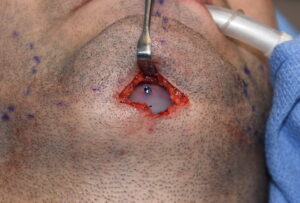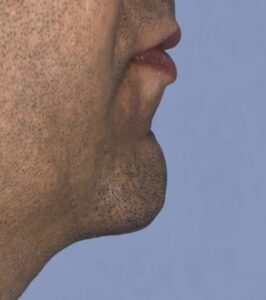Background: The most common dimensional need for many chin augmentations is in the horizontal direction. But the most overlooked dimensional need in chin augmentation is vertical. For some patients the horizontal increase is enough to produce the slight vertical increase that is needed with the forward roll of the soft tissue chin pad. But for others the vertical increase is just as important as the amount of horizontal increase if not more so. In these cases a traditional chin implant approach will not work. And trying to position a chin implant intended for horizontal augmentation off the end of the chin bone for a vertical increase is a conceptually flawed approach.
The need for vertical increase in chin augmentation can be seen in two ways. The chin may simply look vertical short by the facial third assessment. But the shape of the soft tissue chin pad is another giveaway as it will look compressed with a deep labiomental fold. Also the patient may habitually jut their jaw forward as that gives them an improved aesthetic lower facial look.
The historic approach to vertically lengthening the chin is the opening wedge genioplasty. Similar to the bone cut from a sliding genioplasty the down fractures chin bone is vertically lengthened or a combined vertical and horizontal lengthening is done. This is still a very good approach but certain amounts of vertical lengthening can be done by a standard implant. (of course a custom design chin implant is the ideal method)
Case Study: This male had a short compressed chin in which he often held it forward which gave him a better look. The labiomental fold was a deep inverted v shape with an upper tilt to he chin pad.


The vertical lengthening chin implant is effective but it does not have the range of vertical lengthening that an open wedge genioplasty does. This is because in the genioplasty procedure the inferior soft tissue attachments to the chin remain attached to the bone and are carried with it regardless of the vertical lengthening amount. Conversely with a chin implant from the submental direction the soft tissue chin pad attachments are elevated off the bone and an implant is placed between the bone and the released chin pad. If the implant is too big the soft tissue chin pad may not be able to be pulled back over it during closure.
Case Highlights:
1) The vertically short chin is exemplified by a compressed soft tissue chin pad and a deep labiomental fold.
2) The vertically lengthening chin implant offers a non-osteotomy method for vertical chin lengthening in which some horizontal increase is desired as well.
3) The vertical lengthening chin implant can be placed either from either an intraoral or a submental approach in which screw fixation can be applied.
Dr. Barry Eppley
Indianapolis, Indiana





